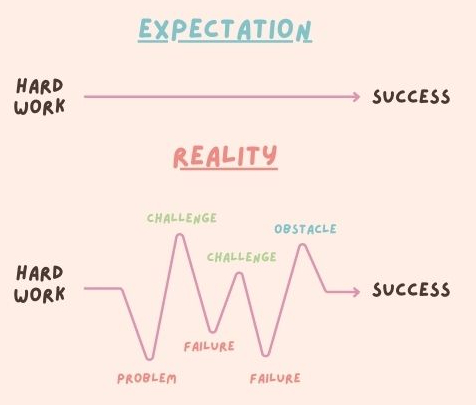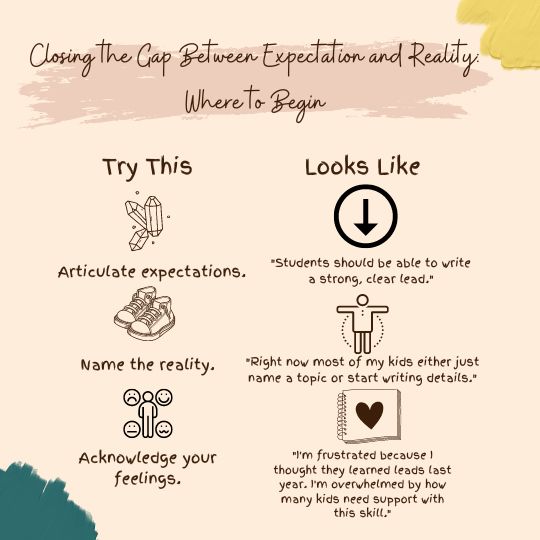My 8-year-old and I love to watch baking shows, from the cute cake-decorating ones on Disney to the unbelievable hyperrealistic creations on Netflix’s Is It Cake? There’s something captivating about watching the creative process unfold, seeing the talent of the artists showcased in real-time, and experiencing the build-up as something amazing is unveiled at the end.
We also binge-watch Nailed It! on Netflix for all of the same reasons: the creative process, the misadventures of the novice bakers, and the anticipation of whatever attempt at baking will be revealed. We definitely share some giggles and some “I would have…” moments as the approximations are compared to the perfect examples.
Doesn’t teaching feel like that many days? It’s easy to feel like we’re surrounded by more perfect examples–teachers who make it look effortless and attainable, a “better” class last year–and, especially at this time of the year, it’s easy to believe our own class will never get there. We’ve hit the notorious slump that happens in the fall when we know our students well and realize that the finish line is far away. This is the time when many of us experience a mismatch between reality and expectations.
The reasons for this mismatch are many. Sometimes there is a mismatch because we are teaching a new grade level (I thought older students would have mastered this by now! I didn’t realize younger students couldn’t do this yet!). Other times the mismatch comes from standards that seem out of reach (How can I expect my fifth graders to punctuate dialogue when they forget periods at the end of their sentences?). And then there’s the elephant in the room right now: many of us are seeing a mismatch between where we think students should be as writers compared to where they really are because of the learning disruptions caused by COVID.
If you, too, are experiencing this mismatch between where you want students to be and where they really are, you’re probably wondering two things:
- Where do I begin?
- How do I close the gaps?
Where Do I Begin?
When things aren’t going as we expect, our brains have a tendency to react to stress by going into “overwhelmed” mode, making it difficult to pinpoint a plan of action. If you’re in this space right now, here are some steps to get started:
- Articulate your expectations. Focusing on a high-priority skill or two, start by naming where you think your students should be, both now and at the end of the school year.
- Name your current reality. Return to the skills you identified and ask yourself, “Where are my students right now?” By thinking through the skills students are lacking, approximating, and misusing, you will begin to see patterns of need and pathways for teaching.
- Acknowledge your feelings. This might be the most challenging step for us as teachers because we tend to feel like we aren’t allowed to feel anything but determination. Hopefully determination and optimism are somewhere in the mix, but it’s also acceptable to feel frustrated, discouraged, and overwhelmed. Sometimes we have to name the feelings before we can move ourselves and our students forward.
How Do I Close the Gaps?
The first and most important thing to remember about gaps is that we cannot close them overnight, no matter how much our hearts wish we could do so. Instead, this work requires an investment of time and intentional planning. When focusing on closing gaps in essential skills in writing, consider the following:
- Think in steps, not leaps. Once you have identified the distance between where your students are currently performing and what you desire to have them achieve by the end of the year, the next teaching move is to develop a clear plan of action between the two. Often we try to take kids from current reality to desired outcomes in one big leap, but this work should be intentional and step-by-step. (Melanie Meehan does a fantastic job explaining this work in her post “Providing Ladders of Expectations”).
- Acknowledge the gap and identify specific goals with students. Teaching is something we do with students, not to students. Therefore, we want to include the kids in this work and involve them in the work of setting and achieving goals.
- Determine the balance of whole group, small group, and individual instruction. If half of your students (or more) are lacking a necessary skill, teaching will best address their needs if done in whole class mini-lessons followed by support in small groups and individual conferences. If only a few students need a skill, small groups or conferences might be a better use of instructional time. Use your students’ writing samples and data to guide the focus and instructional model.
- Provide exemplars across the learning progression. One critical piece of closing learning gaps is to show students writing examples at each step in the progression of learning. This will help them become aware of their current level of performance, clearly see the next step, and understand the desired outcome. It will also reduce the stress that accompanies trying to reach a goal that seems unattainable.
- Be explicit in your teaching. Make sure your lessons are clear, focused, and targeted. Articulate the process and provide clear examples for students to imitate and follow.
- Revisit the focus over time. As much as we would all love to spend two weeks taking a deep dive into punctuation or spelling to close gaps, the reality is that these are skills that take time and patience to develop. Instead of planning one focused sequence of lessons to address a gap, consider how you may return to the skill over and over, raising the level of your expectations over time.
Moving Forward
This work is challenging and some days feels just out of reach, but the truth is that you and your students will do remarkable things this year. The path forward may have some bumps and unexpected turns, but there will be a day late in the spring when you look back to October and are simply amazed by the reality you have created from your expectations.
Discover more from TWO WRITING TEACHERS
Subscribe to get the latest posts sent to your email.




So very real! Love your tips.
LikeLiked by 1 person
I wish I had read something like this several autumns ago when I moved to a new grade level. It’s hard when reality doesn’t match our expectations. Thanks for providing excellent ways to navigate the realities of classroom teaching.
LikeLiked by 1 person